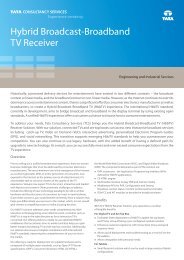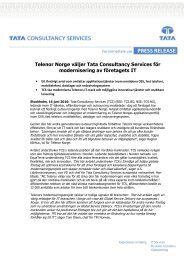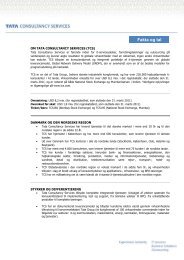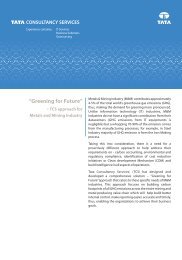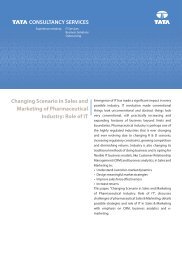TCS Corporate Sustainability Report 2010-11 - Tata Consultancy ...
TCS Corporate Sustainability Report 2010-11 - Tata Consultancy ...
TCS Corporate Sustainability Report 2010-11 - Tata Consultancy ...
Create successful ePaper yourself
Turn your PDF publications into a flip-book with our unique Google optimized e-Paper software.
<strong>Sustainability</strong> of Business Performance<br />
Key stakeholder concerns around the sustainability of our business performance are centered around<br />
five major areas: whether there is sufficient headroom for continued growth, whether the Company’s<br />
size could impede agility, whether supplyside constraints could hamper growth or impact margins,<br />
whether macroeconomic uncertainties or new technologies might impair business and lastly, whether<br />
the company is investing sufficiently in innovation. Some of these concerns are addressed in this<br />
section of the report.<br />
Some of the key risks to our longer-term sustainability, and <strong>TCS</strong>’ approach to mitigating these risks are<br />
summarized on Pages 26-29 of our FY 20<strong>11</strong> Annual <strong>Report</strong>.<br />
Demand-side <strong>Sustainability</strong><br />
<strong>TCS</strong> has had a consistently stellar track-record of revenue growth. Our 6-year CAGR is 22.5% and we<br />
closed FY 20<strong>11</strong> with a revenue of USD 8.187 Bn (up 29.1% YoY).<br />
Other highlights of FY 20<strong>11</strong>:<br />
n 97.8% of revenues from existing customers<br />
n Volume growth of 29.6% YoY<br />
n Gross Margin of 45.3%, EBIT margin of 28.1%<br />
n Gross headcount addition of 69,685<br />
n Net headcount addition of 38,185<br />
<strong>TCS</strong> believes that a strong growth trajectory is sustainable in the foreseeable future because<br />
(a) the global market for IT services is growing, (b) offshore outsourcing is today a mainstream strategic<br />
option, (c) <strong>TCS</strong> has the strong foundational elements needed to partake of this growth and<br />
(d) <strong>TCS</strong>’ strategy for longer-term growth is delivering results.<br />
Global market: Headroom for growth<br />
Figure 5: Revenue Growth in USD (FY2006-20<strong>11</strong>)<br />
According to the IDC-NASSCOM Strategic Review <strong>2010</strong>-20<strong>11</strong>, global spend on IT Services and BPO was<br />
estimated to be $732 Bn in <strong>2010</strong>, i.e. 2% higher than in 2009. This is a highly fragmented market in which<br />
our marketshare is ~1%, suggesting significant headroom for growth.<br />
Going forward, technology spending is expected to further increase as the technology intensity of<br />
businesses increases and lagging verticals as well as geographies play catch up. The 5-year CAGR for the<br />
period 20<strong>11</strong>-2015 is expected to be 4% according to Gartner. Historically, <strong>TCS</strong>’ growth is far higher than<br />
the growth in global spend on IT services. This is due to shifting customer preferences favoring greater<br />
offshore outsourcing – a shift that became even more pronounced in the last few years of global<br />
economic dislocation and drift.<br />
28



